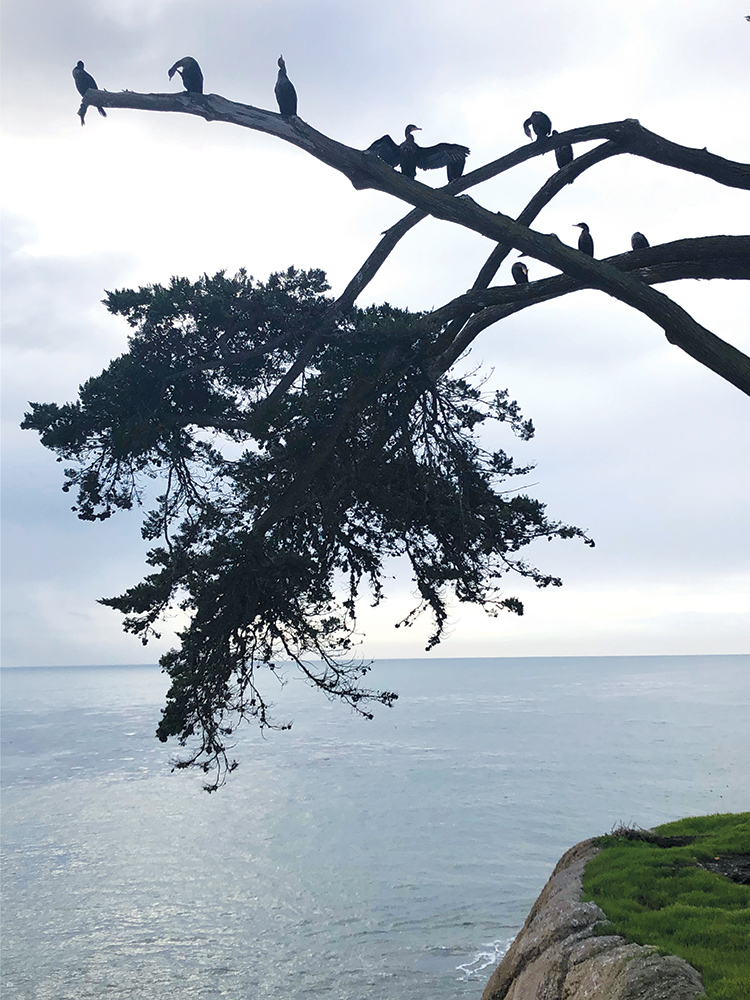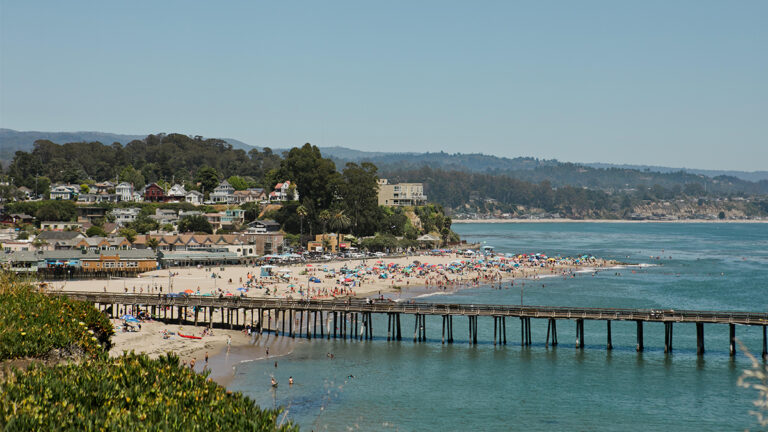By Nicholas Chan
A man in a gray hoodie and flannel pajama pants strolls casually along the walkway. As he nears a mother and her young daughter, he lunges, snatching the woman’s purse, pulling her and the girl down a stairwell to the concrete.
In a flash, he disappears from the frame.
Using old-fashioned methods, tracking down a suspect like this one is an ordeal. In this case, San Jose police canvass the area surrounding the two-story office complex off of Towers Lane on the East Side. Using private security camera footage, investigators reconstruct the crime and identify the suspect’s getaway vehicle, a black Lexus sedan. Detectives ultimately match the purse-snatcher to a string of similar incidents, and five days later the police have their suspect.
On May 11, San Jose police arrested 26-year-old Pablo Cabrera Jr. at his home in San Jose. A search of the premises turned up evidence connecting Cabrera to similar robberies of Asian women carrying pricey purses. He was booked at Elmwood jail on suspicion of robbery and violating a burglary conviction parole. The video footage proved crucial to cracking the case, which recently went to trial.
Security camera footage often helps cops track down other possible criminals, including suspected murderers, like 24-year-old Carlos Arevalo-Carranza, accused of murdering San Jose resident Bambi Larson last year.
“We have solved homicides, sexual assaults and shootings with the use of surveillance cameras that are privately-owned,” SJPD Police Chief Eddie Garcia says. “In the Bambi Larson murder, if it weren’t for stitching those neighborhood camera videos together, I don’t know where that investigation would be.”
To obtain video evidence, officers go door to door, asking for permission from individual camera owners or obtaining a search warrant from a judge. Had SJPD obtained the footage of Cabrera, or Arevalo-Carranza sooner, they might have avoided days of searching for suspects.
But now, some law enforcement agencies have a shortcut. Over in Silicon Valley, San Jose, Santa Clara and Milpitas police departments recently became the first agencies in the South Bay to use a new virtual tool, one that allows detectives to easily obtain privately-owned security video.
The Neighbors App, created by the Amazon-owned networked doorbell and home security camera maker Ring, connects users to security videos of suspicious or criminal activity in the surrounding community. The service is billed as “The New Neighborhood Watch” in ads.
The Amazon subsidiary has also created a “Law Enforcement Portal” that allows investigators to request home-security videos from residents through the app. Over the past year, however, Ring has faced mounting scrutiny, including a negligence suit over hacked cameras. Earlier this month, Amazon announced in an email to five concerned U.S. Democratic senators that it fired four employees who abused internal access and spied on customers.
Since launching its Law Enforcement Portal for the Neighbors App in the spring of 2018, nonetheless, the digital doorbell company has teamed up with more than 400 police departments across the United States.
The partnerships between local law enforcement and Ring raise concerns about privacy—and the creeping corporate sway on public policy. Civil liberties advocates sound alarms about Ring’s terms of service with police, warning that local law enforcement has become a promoter of an ecommerce monopolist that already has huge stockpiles of personal data, including groceries purchased, shows watched, books read, music enjoyed. Some police departments even let Amazon, which has offices in downtown Santa Cruz, control aspects of their messaging. It sets a dangerous precedent, critics argue, for law enforcement agencies to grant leverage over their messaging to one of the world’s most powerful companies.
“The company is looking out for their bottom line,” says Matthew Guariglia, policy analyst at the Electronic Frontier Foundation, a digital rights advocacy group. “So when they get the machine of government working for their benefit, you don’t know as a citizen if the police department in your town is looking out for your best interest or Amazon’s interest.”
CORPORATE PR
Here in Santa Cruz County, no local law enforcement departments have deals with Ring, although Scotts Valley began looking into the program last year.
Capitola has used footage submitted by citizens to assist with investigations, although it doesn’t have any access on the back end of the portal.
And the Santa Cruz County Sheriff’s Office, for its part, has its own neighborhood video partnership that residents may sign up for. In November after the murder and kidnapping of Tushar Atre from his Pleasure Point Home, the sheriff’s office released survellience footage from a nearby home of the suspects walking through the neighborhood, carrying a duffle bag and a rifle.
In Watsonville, Police Department spokesperson Michelle Pulido tells GT in an email, that her employer doesn’t have plans to make sort of any agreement with Ring. “If we were to partner with the company in the future, we would first need to ensure the benefits for our residents outweigh any possible concerns,” she writes.
Over in Silicon Valley, it’s a different story. Ring—under its agreements with San Jose and Santa Clara—can control the content of press releases about the police departments’ partnerships with Ring. The company also expects to approve any Ring-related public service announcements from Santa Clara PD. Even SJPD’s social media posts are scripted by Ring.
“It’s very concerning when an enormous corporation is writing the press releases for the government. People think their police department is speaking, when, in fact, it’s Amazon that’s speaking,” American Civil Liberties Union (ACLU) attorney Jacob Snow says. “It’s using police departments as the mouthpiece for a giant corporation.”
A trail of records illustrates the nature of partnerships between local agencies and the doorbell-surveillance company. In one of those documents, Angela Kang, who manages public agency partnerships for Ring, wrote in an email to Santa Clara PD that all press release drafts must be submitted in advance to me***@**ng.com.”
Kang sent the department four attachments of press release materials—a “Press Release Template,” “Sample Social Media Posts,” “Talking Points and Reactive Q&A Sheet,” and “Neighbors App Logo and Imagery.”
When this news organization asked Santa Clara police to include those attachments, they denied the request without offering any justification. According to Dave Snyder, executive director of the San Rafael-based free-speech non-profit First Amendment Coalition, that’s a clear violation of the California Public Records Act (CPRA), which requires the government to disclose public records upon request and cite specific exemptions to the law in order to deny requests for information. A Santa Clara County Civil Grand Jury slammed the city for the same offense earlier this summer.
Per the terms of their contracts with Ring, neither police San Jose nor Santa Clara can disclose the terms of their video surveillance program with Ring. San Jose’s agreement with the company does include a provision, though, for complying with requests for certain documents made under the CPRA.
Such language about the CPRA is missing from Santa Clara’s memo.
According to Snyder, that’s a problem. “It gives broad discretion to Ring to designate records as confidential,” he explains. “It appears to give a private entity the final say about what’s public and what’s not. That’s improper. The Public Records Act makes clear that a government agency has an independent obligation to provide records and cannot put the public rights of access in the hands of a private company.”
San Jose police proved more forthcoming than their counterparts in Santa Clara. Records obtained from SJPD show that Ring sent the department talking points and fill-in-the-blank templates for its social media announcements on Facebook, Nextdoor and Twitter.
And according to a review of the messaging, SJPD’s social media posts have largely mirrored Ring’s templates.
A Ring representative, who asked to be identified only as a spokesperson for the company, wrote in an email that “Ring requests to look at press releases and any messaging prior to distribution to ensure our company and our products and services are accurately represented.” The Ring official wrote that police departments can use Ring’s social media templates at their discretion.
Andrew Ferguson, author of The Rise of Big Data Policing, says everyone should be leery of Ring’s reach.
“We should pause when a private company is demanding editorial oversight of public press releases about public safety,” Ferguson says. “That is an unusual move and seems to infringe on the question of who the city is working for and with.”
For his part, SJPD Chief Garcia insists that he has the final stamp of approval when it comes to his department’s messaging. If Ring disagrees with his press releases and ultimately wishes to end its partnership, then so be it—he says he’ll severe ties with the company.
But another point of concern for privacy advocates is the lack of public oversight inherent in these kinds of contracts. “People in town have no say about the existence of the partnership,” says the Electronic Frontier Foundation’s Guariglia. “It’s not being discussed in city council.”
PUBLIC AND PRIVATE
Critics worried about Ring aiding and abetting Big Brother are overreacting, California Police Chief Association President Ronald Lawrence says.
After all, this app simply expedites surveillance video requests for police departments. “ACLU and their advocacy groups tend to spin this,” he argues. “Police agencies have no desire to be in the 24/7 surveillance arena. Furthermore, we don’t even have the resources. There’s no infrastructure.”
To those concerned about corporate overreach, Lawrence says that private companies have long done business with police departments. For example, Axon, the manufacturer of the Taser, is also one of the largest vendors of police body cameras; gun manufacturers Sig Sauer and Glock are major suppliers of firearms; telecom giant Motorola owns a large share of the radio infrastructure for police and fire departments across the nation.
As technology has evolved rapidly over the last decade, Lawrence says it’s prudent for police departments to partner with technology companies to upgrade their tools. The Neighborhood App is just the latest example in a long line of public and private policing partnerships.
Civil liberties groups have a history of thwarting the efforts of law enforcement to adopt modern technology, Lawrence says, and Police Chief Association leaders are getting worried. Ring isn’t their first target, he notes. Civil liberties advocates successfully backed a bill to temporarily ban facial recognition in police body cams.
“We faced the same [problem] when Tasers first emerged. People said, ‘Oh my god, you can’t have that.’ Well the reality is, the use of police baton—a far more blunt instrument—decreased significantly,” Lawrence says. “We need to embrace technology.”
NEW NORMAL
Privacy advocates say these kinds of privately penned, publicly adopted policies are becoming the new status quo. As Ring continues to expand its partnerships, Ferguson warns that Amazon is gaining unfettered access to people’s daily lives.
Supporters of surveillance technology’s growing reach argue that the potentially chilling effect of crime overshadows any concerns about personal privacy and government transparency. “Anyone that is against using cameras to deter crime and convict criminals has to reassess their values,” SAFER San Jose President Issa Ajlouny says. “People are sick and tired of the crime that’s going on a daily basis.”
All over the world, consumers have voluntarily adopted smart speakers with always-on microphones, like the Amazon Echo and Google Home. (Google also owns the wifi camera and smart thermostat maker Nest.) Our phones, watches and even our appliances are increasingly collecting information from sensors and beaming it to the cloud, where the data is stored and can potentially be correlated with personal profiles.
“Amazon is selling surveillance as a service,” Ferguson says. “They are building more and more information about all of us. We are normalizing ordinary surveillance, building networks of surveillance in certain neighborhoods that will have a chilling effect for people going about their business.”


























